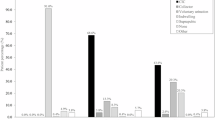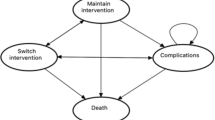Abstract
Study design: A retrospective study.
Objectives: (1) To raise awareness of flawed trial of micturition (TOM) in male spinal cord injury (SCI) patients; and (2) to present guidelines for trial of voiding in male SCI patients.
Setting: Regional Spinal Injuries Centre, Southport, UK.
Methods: Trial of micturition in male SCI patients refers to discarding indwelling catheters and establishing them on balanced voiding with penile sheath drainage. We describe seven SCI patients, whose trial of micturition was flawed.
Results: Two patients (C-6 and C-4 tetraplegia respectively) developed severe autonomic dysreflexia (headache, sweating, and increase in blood pressure) 2–3 h after removal of urethral catheter. A C-4 tetraplegic developed severe urinary infection after TOM. Four patients with tetraplegia started retaining increasing amounts of urine and developed urinary infections/autonomic dysreflexia/hydronephrosis 1–21 months after they were established on sheath drainage after TOM.
Conclusion: During TOM, patients with cervical SCI could develop autonomic dysreflexia, urinary infection, or hold progressively increasing volumes of residual urine. TOM should be guided by videourodynamics. SCI patients need α-blockers, and anticholinergics if voiding pressures are >40–50 cmH2O. If high urethral resistances are found, sphincterotomy and/or bladder neck incision will help the patients to void by triggering. SCI patients, who had undergone successful TOM, require meticulous follow-up including urodynamics. Intermittent catheterisation without adequate medications based on cystometrogram may be hazardous, and may result in upper tract damage. Facilities for supplementary catheterisation (three to four times a day) should be available in the community if a patient is unable to maintain complete, low-pressure, emptying of bladder.
Similar content being viewed by others
Log in or create a free account to read this content
Gain free access to this article, as well as selected content from this journal and more on nature.com
or
References
Wyndaele JJ, De Sy WA, Claessens H . Evaluation of different methods of bladder drainage used in the early care of spinal cord injury patients. Paraplegia 1985; 23: 18–26.
Vaidyanathan S et al. The method of bladder drainage in spinal cord injury patients may influence the histological changes in the mucosa of neuropathic bladder – a hypothesis. BMC Urol 2002; 2: 5.
Madersbacher H et al. Conservative management in neuropathic urinary incontinence. In: Abrams P, Cardozo L, Khoury S, Wein A (eds). Incontinence, second International Consultation on Incontinence, Paris, 1–3 July 2001 2nd edn. Plymbridge Distributors Ltd: Estover Road, Plymouth 2002, pp 697–754.
Brynne N et al. Pharmacokinetics and pharmacodynamics of tolterodine in man: a new drug for the treatment of urinary bladder overactivity. Int J Clin Pharmacol Ther 1997; 35: 287–295.
Wyndaele JJ . Urethral sphincter dyssynergia in spinal cord injury patients. Paraplegia 1987; 25: 10–15.
Wyndaele JJ . A critical review of urodynamic investigations in SCI patients. Paraplegia 1984; 22: 138–144.
Perkash I, Giroux J . Clean intermittent catheterisation in spinal cord injury patients: a follow-up study. J Urol 1993; 149: 1068–1071.
Kabalin JN, Rosen J, Perkash I . Penile advancement and lengthening in spinal cord injury patients with retracted phallus who have failed penile prosthesis placement alone. J Urol 1990; 144(2 Part 1): 316–318.
Maynard FM . Posttraumatic cystic myelopathy in motor incomplete quadriplegia presenting as progressive ortho-stasis. Arch Phys Med Rehabil 1984; 65: 30–32.
Barber DB, Rogers SJ, Fredrickson MD, Able AC . Midodrine hydrochloride and the treatment of orthostatic hypotension in tetraplegia: two cases and a review of the literature. Spinal Cord 2000; 38: 109–111.
Gruenenfelder J, McGuire EJ, Faerber GJ . Acute urinary retention associated with the use of cyclooxygenase-2 inhibitors. J Urol 2002; 168: 1106.
Vaidyanathan S et al. Dosage of once-daily gentamicin in spinal cord injury patients. Spinal Cord 2000; 38: 197–198.
Vaidyanathan S et al. Pathophysiology of autonomic dysreflexia: long-term treatment with terazosin in adult and paediatric spinal cord injury patients manifesting recurrent dysreflexic episodes. Spinal Cord 1998; 36: 761–770.
Vaidyanathan S et al. Possible use of indoramin in patients with chronic neurogenic bladder dysfunction. J Urol 1983; 129: 96–101.
Lanning P, Seppanen U, Huttunen NP, Uhari M . Prediction of vesico-ureteral reflux in children from intravenous urography films. Clin Radial 1979; 30: 67–70.
Scher AT . Changes in the upper urinary tract as demonstrated on intravenous pyelography and micturating cysto-urethrography in patients with spinal cord injury. Paraplegia 1975; 13: 157–161.
Arnold EP, Cowan IA . Clinical significance of ureteric diameter on intravenous urography after spinal cord injury. Br J Urol 1988; 62: 131–135.
Mertens P et al. Long-term clinical, electrophysiological and urodynamic effects of chronic intrathecal baclofen infusion for treatment of spinal spasticity. Acta Neurochir Suppl (Wien) 1995; 64: 17–25.
Vaidyanathan S et al. Community-care waiting list for persons with spinal cord injury. Spinal Cord 2001; 39: 584–588.
Acknowledgements
We express our sincere thanks and gratitude to Dr Inder Perkash, Director, Regional Centre for Spinal Cord Injuries, Veterans Affairs Health Care System, Palo Alto, California, USA, and Professor Jean-Jacques Wyndaele, Professor of Urology, University of Antwerpen, Belgium.
Dr Inder Perkash and Professor Jean-Jacques Wyndaele made valuable comments, which greatly helped in formulating the above guidelines for trial of micturition in the patients with cervical spinal cord injury.
We thank the reviewers of this manuscript. The reviewers made valuable remarks and we are grateful to the reviewers for very helpful suggestions.
Author information
Authors and Affiliations
Rights and permissions
About this article
Cite this article
Vaidyanathan, S., Soni, B., Sett, P. et al. Flawed trial of micturition in cervical spinal cord injury patients: guidelines for trial of voiding in men with tetraplegia. Spinal Cord 41, 667–672 (2003). https://doi.org/10.1038/sj.sc.3101519
Published:
Issue date:
DOI: https://doi.org/10.1038/sj.sc.3101519
Keywords
This article is cited by
-
Iatrogenic urological triggers of autonomic dysreflexia: a systematic review
Spinal Cord (2015)
-
Urinary incontinence in spinal cord injured individuals 10–45 years after injury
Spinal Cord (2010)



